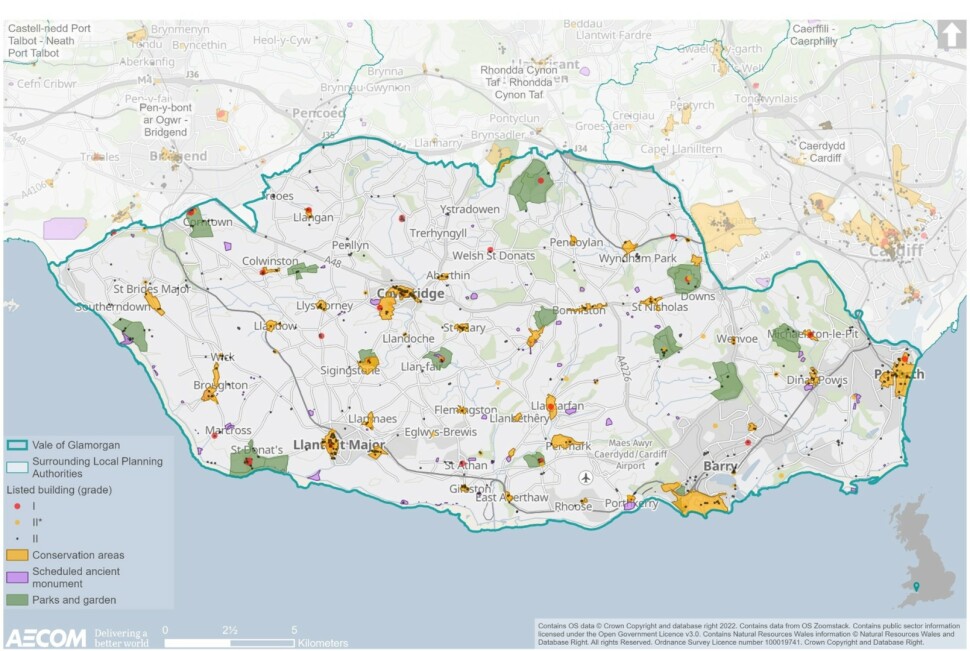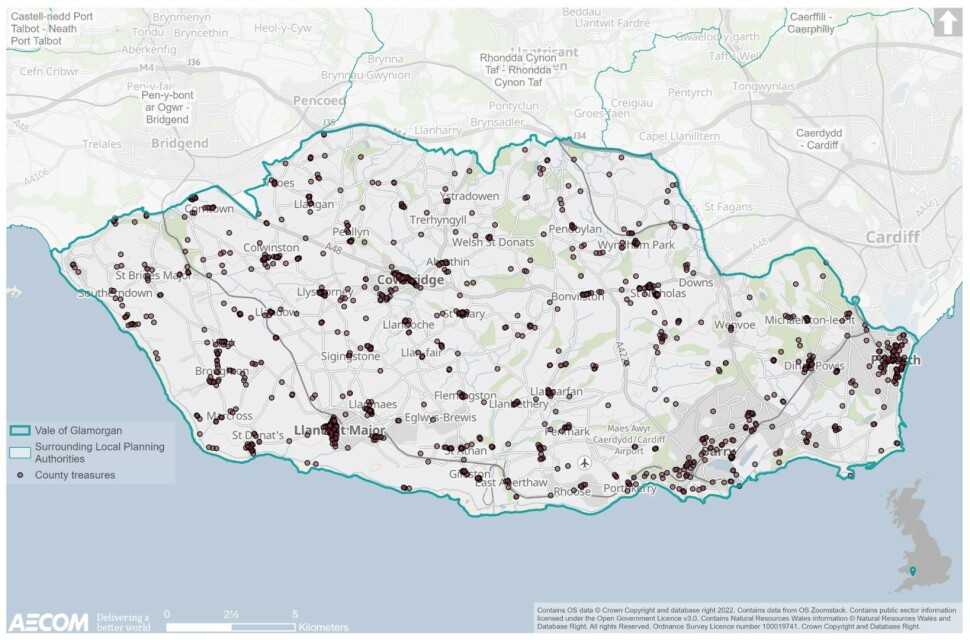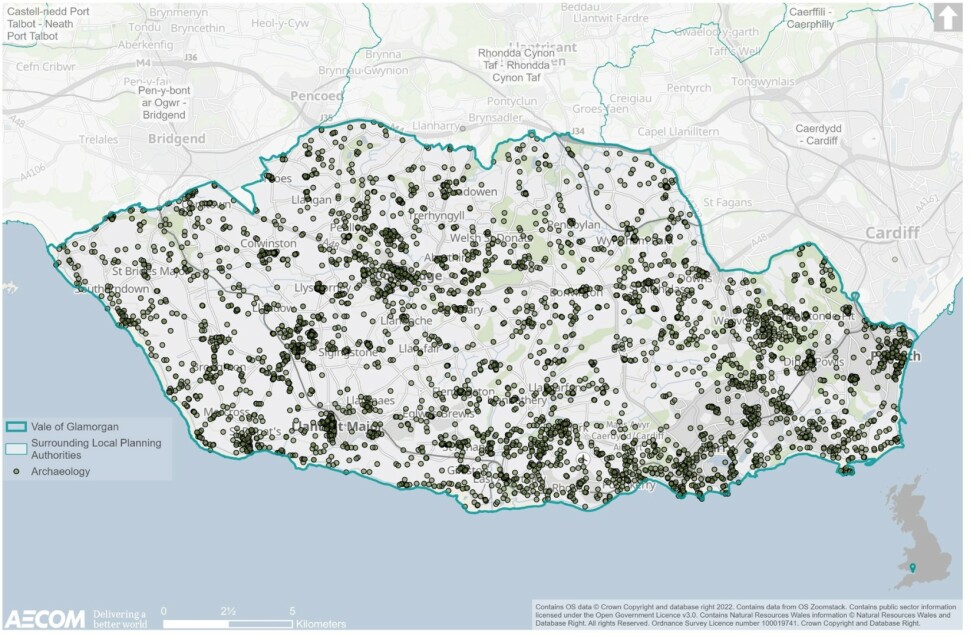Integrated Sustainability Appraisal (ISA) Scoping Report
10. Historic environment
10.1 This theme focuses on designated and non-designated historic assets (including archaeology) and their setting.
Policy context
10.2 Table 10.1 presents the most relevant documents identified in the policy review for the purposes of the RLDP and ISA.
Table 10.1 Plans, policies and strategies reviewed in relation to the historic environment
Document title
Year of publication
2015
Various
Vale of Glamorgan Conservation Area Management Plans
2009
10.3 Key messages emerging from the review are summarised below:
- The Historic Environment (Wales) Act is one piece of legislation that will form part of a suite of legislation, policy, advice and guidance that will make important improvements to the existing systems for the protection and sustainable management of the Welsh historic environment.
- The Historic Environment Strategy for Wales recognises the contribution of the historic environment to the quality of life in Wales, and therefore sets out measures to enable the protection of local heritage and encourage public access, enjoyment and participation. Proposed measures seek to contribute to quality of life and quality of place and support the tackling poverty agenda. They will also create individual and community confidence and a sense of belonging.
- The RLDP will be required to be in general conformity with Future Wales, which sets out the 20-year spatial framework for land use, providing a context for the provision of new infrastructure/ growth. Future Wales identifies Vale of Glamorgan as falling within the South East Wales region, the smallest of the four regions by area, including the coastal cities of Cardiff and Newport and the former industrial heartlands of the south Wales valleys. The RLDP should set out policies and proposals reflecting the structural economic and social issues that impact upon residents' prosperity and well-being. This helps to create healthy, vibrant places, protecting the natural environment and the historic environment.
- PPW and supplementary TANs provide national planning policy in respect of the historic environment. Local Planning Authorities should not repeat national policy but include clear robust policies on design in their development plans which address local issues and should be based on relevant evidence. These should set out the local planning authority's design expectations.
- TAN 12 (Design) identifies 'character' as one of the five aspects of good design. Objectives in this respect include 'sustaining and enhancing local character', utilising design to respond to 'recognisable and understood features and landmarks' and 'locally distinctive patterns and forms of development'.
- TAN 24 (Historic Environment) provides guidance on how the planning system considers the historic environment during development plan preparation and decision making, with specific guidance provided on how the following aspects of the historic environment should be considered:
- world heritage sites.
- scheduled monuments.
- archaeological remains.
- listed buildings.
- conservation areas.
- historic parks and gardens.
- historic landscapes; and
- historic assets of special local interest. - The Placemaking Wales Charter builds on the strengthening focus on placemaking in policy and practice in Wales and aims to provide a common understanding of the range of considerations that go into placemaking. The charter outlines the following six placemaking principles that cover the range of considerations that contribute to establishing and maintaining good places:
- People and community.
- Movement.
- Location.
- Public realm.
- Mix of uses; and
- Identity. - Cadw has produced a series of best-practice guidance publications that complement the legislative framework and associated planning policy and advice and support the sustainable management of the Welsh historic environment. All are informed by Cadw's Conservation Principles for the Sustainable Management of the Historic Environment in Wales. Fourteen titles have been released so far, many of which are intended for local planning authorities, to support the development of policies and proposals relating to the protection and enhancement of the historic environment and the promotion of the Welsh language.
- Notably, the Welsh Government has identified Wales' historic environment law as a suitable subject for one of its first projects in an ambitious programme of legislative consolidation. If all goes to plan, the outcome will be new, fully bilingual legislation that is orderly, clear and easily accessible[167].
Baseline summary
10.4 The Vale of Glamorgan historic environment embraces many features, including buildings, structures, monuments, remains, archaeological sites, gardens, parks, landscapes (see Chapter 11) and their settings. The location of designated historic assets, including scheduled ancient monuments, listed buildings, parks and gardens, conservation areas and maritime assets, are presented in Figure 10.1 later in this Chapter.
Listed buildings
10.5 The Vale of Glamorgan currently has 740 Listed Buildings whose special architectural or historic interest is protected by the need to obtain Listed Building Consent under the provisions of the Planning (Listed Buildings & Conservation Areas) Act 1990.[168] The setting of such buildings, is often critical to the character of the building, and can be restricted to its immediate site or extend to a much wider area.
10.6 Of the 740 Listed Buildings within the Vale, 33 are Grade I Listed.
10.7 Figure 10.1 shows that Listed Buildings are located throughout the Vale, concentrated to some extent within settlements such as Penarth, Llantwit Major and Cowbridge, coinciding with Conservation Areas (discussed below).
Scheduled Monuments (SMs)
10.8 There are 114 SMs designated throughout the Vale (see Figure 10.1). These are scattered throughout the authority, with no obvious concentrations.
Registered Parks and Gardens
10.9 There are 38 Registered Parks and Gardens present within the Vale. Of these, 'St Donat's Castle' and 'Dyffryn' are Grade I Listed. Figure 10.1 shows Parks & Gardens are also relatively sporadic in their location, with arguably a slight concentration to the northeast and southwest of the Vale.
Conservation Areas
10.10 As shown in Figure 10.1, there are 40 Conservation Areas present, which make a significant contribution to the attractiveness of the Vale.
10.11 The Vale's Conservation Areas have been designated because of the overall quality of the area, its mix of uses, historic layout, characteristic materials, scale and detailing of buildings and open spaces.
10.12 The Council has prepared detailed appraisals for each of its designated conservation areas, which can be found here. The appraisals define special characteristics of the conservation areas and propose guidelines for development and enhancement schemes. These have been adopted by the Council as Supplementary Planning Guidance in support of the policies of the adopted LDP.
Figure 10.1 National heritage designations
Register of Landscapes of Historic Interest in Wales
10.13 The Vale of Glamorgan includes two areas on the Register of Historic Landscapes in Wales. These assets, along with the wider historic landscape value of the Vale are discussed further within Chapter 11.
County Treasures
10.14 In partnership with the wider community, the Council has identified buildings and structures within the Vale of Glamorgan considered to have special local architectural or historic interest. These 'County Treasures' are of significance to the local community and contribute to the environmental and cultural heritage of the County. Although not of national importance required to merit statutory listing, their local value deserves preservation and regard must be given to the need for development proposals to protect such assets from insensitive development which individually and cumulatively can harm local character.
10.15 As shown in Figure 10.2 below, there are 1,240 County Treasure local entries within the Vale. These located throughout the county borough, with clusters seen within the main settlements (i.e., Cowbridge, Llantwit Major, and Penarth).
10.16 Each County Treasure has been assessed in terms of its merits, integrity and authenticity.[169] Locally identified features/buildings were identified by means of a partnership between the Council, representatives of town/community councils, the Penarth Society, other local amenity societies and independent local volunteers.
10.17 The local element of the County Treasures list contains buildings and structures within the Vale of Glamorgan, considered as having special local architectural or historic interest. They are of significance to the local community and to contribute to the environmental and cultural heritage of the county borough. Although not of national importance required to merit statutory listing, their local value deserves preservation.
Archaeology
10.18 As shown in Figure 10.3, the Vale of Glamorgan has considerable archaeological interest, with concentrations seen around key settlements. The Glamorgan-Gwent Archaeological Trust curates the authority's Historic Environment Record.[170]
Locally significant historic assets
10.19 Historic assets of local significance (HALS) identify local historic assets that have a particularly pertinent role in the local historical or architectural context of an area. HALS play an essential role in building and reinforcing a sense of local character and distinctiveness through the historic environment. Whilst the Council does not currently keep a record of locally significant archaeological assets, consultation with The Glamorgan-Gwent Archaeological Trust as part of the RLDP will enable the Council to consider these assets when future development proposals are under consideration by the Council.
Future baseline
10.20 The Vale is rich in historic built and natural assets, including 740 listed buildings, over 100 SMs, 40 Conservation areas, 18 areas included in the Register of Landscapes of Historic Parks and Gardens, two areas on the Register of Landscapes of Historic Interest in Wales, and the Glamorgan Heritage Coast.
10.21 In the absence of the RLDP, designated and non-designated historic assets are likely to continue to be afforded protection through national planning policy as well as currently adopted policies.
10.22 In the absence of the RLDP potential opportunities, in particular cross-boundary ones, could be missed to improve the landscape/ townscape and therefore enhance the historic environment.
Key issues
10.23 The context review and baseline information informed the identification of several key issues (problems and opportunities):
- The Vale has a rich variety and distribution of historic assets, including 740 listed buildings, over 100 SMs, 40 Conservation areas, 18 areas included in the Register of Landscapes of Historic Parks and Gardens, and two areas on the Register of Landscapes of Historic Interest in Wales. The significance and setting of these assets should be considered in, and positively impacted upon by, new development.
- Development should be sensitively designed to maintain a strong sense of place, using the arrangement of streets, spaces, building types and materials to create attractive, welcoming and distinctive places to live, work and visit.
- All development should ensure that any necessary archaeological investigations are undertaken prior to any relevant works.
ISA objectives
10.24 Considering the key issues discussed above, it is proposed that the ISA should include the following objective and assessment questions:
| ISA objectives | Assessment questions – will the option/proposal help to: | |
|---|---|---|
| Preserve and enhance Vale of Glamorgan's heritage resource, including its historic environment and archaeological assets. |
|
|
| Promote understanding of Vale of Glamorgan's cultural heritage. | ||
[168] Vale of Glamorgan (no date): 'Our Environment Evidence Report', [online] available to access via this link
[169] Vale of Glamorgan Council (2009): 'Supplementary Planning Guidance: County Treasures', [online] available to access via this link
[170] Glamorgan-Gwent Archaeological Trust Ltd (no date): 'Data Access and submission', [online] available to access via this link




